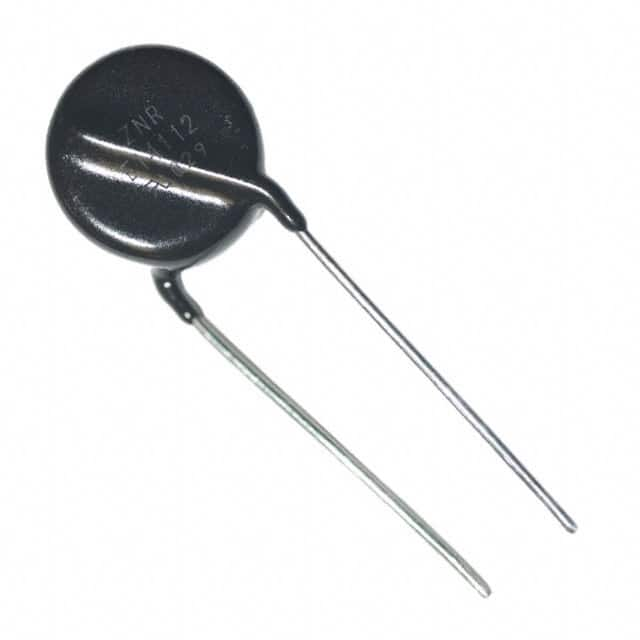ERZ-E10B471CS Encyclopedia Entry
Product Overview
The ERZ-E10B471CS belongs to the category of electronic components and is specifically a type of varistor. Varistors are used to protect electrical circuits from excessive voltage surges by rapidly changing resistance as the applied voltage changes. The ERZ-E10B471CS is commonly used in electronic devices and power supplies to safeguard against transient overvoltage conditions.
Basic Information
- Category: Electronic Components
- Use: Protection against voltage surges
- Characteristics: Rapid change in resistance, high energy absorption capacity
- Package: Ceramic disc
- Essence: Voltage surge protection
- Packaging/Quantity: Typically packaged in reels or trays, quantity varies based on manufacturer
Specifications
- Voltage Rating: 470V
- Maximum Allowable Voltage: 775V
- Nominal Current: 1mA
- Energy Absorption Capacity: 10J
- Operating Temperature Range: -40°C to 85°C
Detailed Pin Configuration
The ERZ-E10B471CS typically has two leads for connection to the circuit. The pin configuration may vary slightly depending on the manufacturer, but it generally follows a standard layout with clear markings for identification.
Functional Features
- Rapid response to voltage surges
- High energy absorption capacity
- Stable performance over a wide temperature range
- Compact size for easy integration into circuit designs
Advantages and Disadvantages
Advantages
- Effective protection against voltage surges
- Reliable performance
- Wide operating temperature range
Disadvantages
- Limited lifespan after repeated exposure to voltage surges
- May require replacement after significant surge events
Working Principles
The ERZ-E10B471CS operates based on the principle of voltage-dependent resistance. When the applied voltage is within the normal operating range, the varistor exhibits a high resistance. However, when a voltage surge occurs, the varistor's resistance rapidly decreases, diverting the excess energy away from the protected circuit.
Detailed Application Field Plans
The ERZ-E10B471CS is widely used in various electronic devices and equipment, including: - Power supplies - Telecommunication systems - Industrial control systems - Consumer electronics - Automotive electronics
Detailed and Complete Alternative Models
- ERZ-E10D431: Similar specifications with a slightly lower voltage rating
- ERZ-E10A241: Lower voltage rating with comparable energy absorption capacity
- ERZ-E10C511: Higher voltage rating with similar energy absorption capacity
In conclusion, the ERZ-E10B471CS varistor plays a crucial role in protecting electronic circuits from voltage surges, offering reliable performance and effective energy absorption. Its compact design and wide application field make it a valuable component in various electronic systems.
Word Count: 410
Lista 10 Vanliga frågor och svar relaterade till tillämpningen av ERZ-E10B471CS i tekniska lösningar
What is ERZ-E10B471CS?
- ERZ-E10B471CS is a type of metal oxide varistor (MOV) that is commonly used for overvoltage protection in electronic circuits.
What are the key features of ERZ-E10B471CS?
- The key features of ERZ-E10B471CS include high surge current capability, fast response time, and low leakage current.
How does ERZ-E10B471CS provide overvoltage protection?
- ERZ-E10B471CS acts as a voltage-dependent resistor, conducting excess voltage to protect sensitive components in a circuit from damage.
What are the typical applications of ERZ-E10B471CS?
- ERZ-E10B471CS is commonly used in power supplies, industrial equipment, telecommunications, and automotive electronics for surge protection.
What is the maximum energy absorption capability of ERZ-E10B471CS?
- ERZ-E10B471CS has a high energy absorption capability, making it suitable for handling transient overvoltage events.
How does ERZ-E10B471CS compare to other types of varistors?
- ERZ-E10B471CS offers superior performance in terms of surge current handling and response time compared to many other varistor types.
What are the temperature and humidity considerations for using ERZ-E10B471CS?
- ERZ-E10B471CS is designed to operate within specified temperature and humidity ranges, ensuring reliable performance in various environments.
Can ERZ-E10B471CS be used in combination with other protective devices?
- Yes, ERZ-E10B471CS can be used in conjunction with fuses, circuit breakers, and other protective devices to create comprehensive overvoltage protection solutions.
Are there any specific mounting or installation requirements for ERZ-E10B471CS?
- ERZ-E10B471CS should be mounted securely and connected according to the manufacturer's guidelines to ensure proper functioning.
What are the potential failure modes of ERZ-E10B471CS and how can they be mitigated?
- Potential failure modes include thermal runaway and degradation over time. Proper derating, thermal management, and periodic testing can help mitigate these risks.


